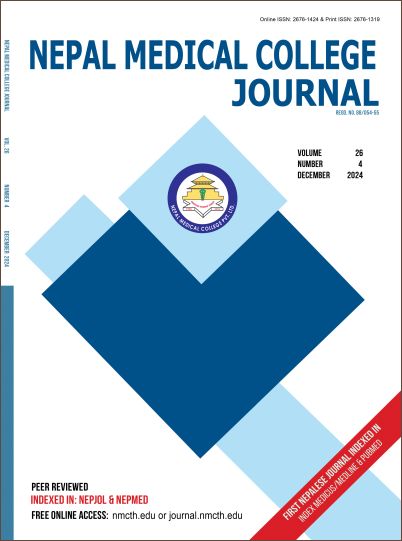Incidence and Risk Factors of Meconium Stained Amniotic Fluid in Newborn at a Tertiary Care Centre of Nepal: A Retrospective Study
DOI:
https://doi.org/10.3126/nmcj.v26i4.74454Keywords:
APGAR score, meconium aspiration syndrome, meconium-stained amniotic fluidAbstract
Meconium stained amniotic fluid (MSAF) is a common cause of perinatal morbidity and mortality in neonates. Meconium has been considered as a sign of fetal distress occurring due to hypoxia which remains a major concern for obstetricians and Neonatologists. Good intrapartum care, timely interventions of all babies and selective approach of endotracheal intubation can reduce its complications to a greater extent. This was a hospital based retrospective cross-sectional study of neonates admitted at Nepal Medical College Teaching Hospital (NMCTH) during the period of January 2021 to Dec 2022. A total of 4171 deliveries was conducted during the study period. Only 265 (6.35%) cases were with meconium stained amniotic fluid. Among them, 74 (27.9 %) cases were vaginal deliveries and 191 (72.1 %) cases born via caesarian section. Out of 265 babies with MSAF, 165 (62.3%) and 100 (37.7%) were male and female respectively. Baby’s weight range was 2.5 to 3.5 kg. Among 265 neonates, two hundred and thirty-five newborns (88.7%) were vigorous and thirty neonates (11.3%) were non -vigorous and required resuscitation. Maternal risk factors for MSAF in increasing frequency were thick meconium, oligohydramnios, intrauterine growth restriction, diabetes mellitus, premature rupture of membrane (PROM) and post term pregnancy. Babies with APGAR scoring less than 7 had Odds ratio (95% Cl): 9.31 (3.54- 24.43) that is babies had 9.31 times more risk of developing meconium aspiration syndrome than with babies of APGAR score more than 7. Out of 265 cases, 88.3% required resuscitation in the form of orogastric suction at birth followed by bag and mask ventilation in 9.8 % cases. 117 (44.1%) babies were put on respiratory support. Out of 265 cases, 261 (98.5%) babies were discharged, 2 (0.8%) cases died and 2 (0.8 %) babies were left against medical advice.
Downloads
Downloads
Published
How to Cite
Issue
Section
License
Copyright (c) 2024 Nepal Medical College Journal

This work is licensed under a Creative Commons Attribution 4.0 International License.
This license enables reusers to distribute, remix, adapt, and build upon the material in any medium or format, so long as attribution is given to the creator. The license allows for commercial use.




